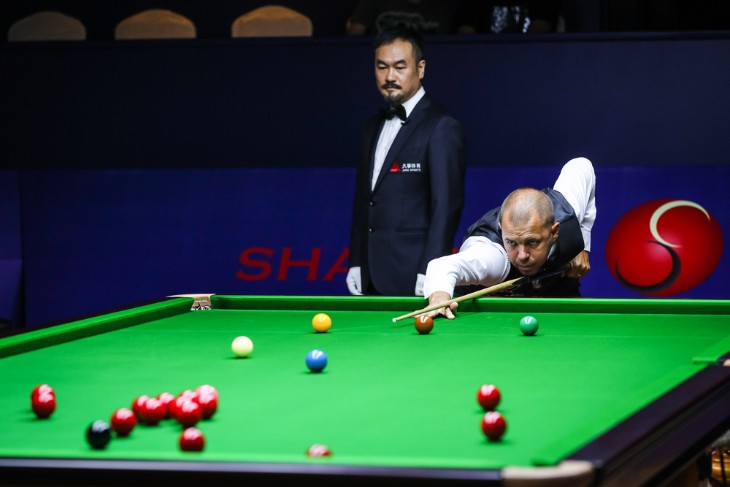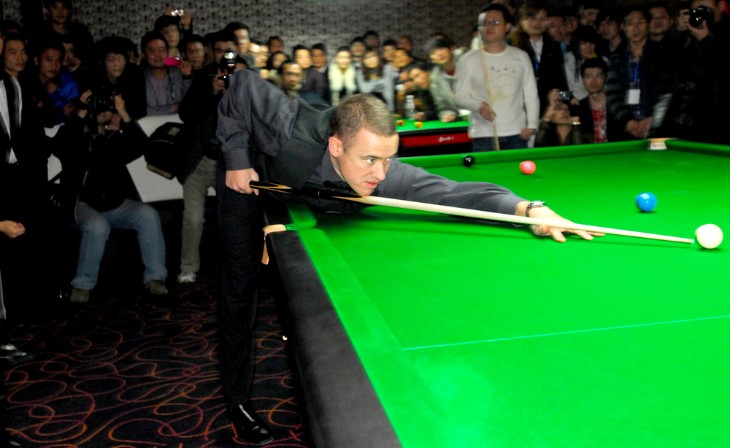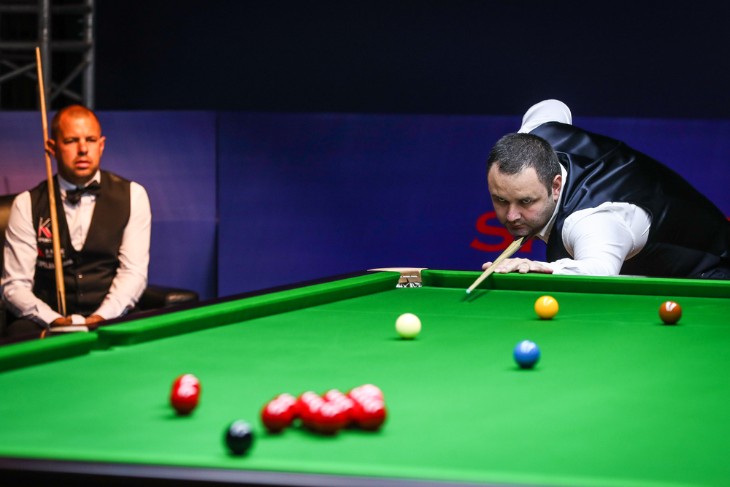Billiards, a cue sport with a long and storied history, differs significantly from its sibling game, snooker. The origins of billiards can be traced back to various indoor games played in Europe during the Middle Ages. In its early form, billiards involved players using a wooden stick, called a mace, to hit a wooden ball. The objective was to score points by driving the ball into pockets or targets on a rectangular table. Over time, the game underwent several transformations and refinements, eventually evolving into what we now recognize as billiards.
One of the notable distinctions between billiards and snooker is the absence of coloured balls in billiards. Instead, billiards traditionally features three balls – one white and two red. The primary objective of the game is to score points by striking the cue ball to make it contact both red balls consecutively or to score specific carom shots, where the cue ball hits both reds and then a target ball. Billiards requires a high degree of precision, control, and mastery of angles, making it a favourite among those who appreciate the subtleties of cue sports. The game has a rich heritage, with different variations and regional preferences contributing to its enduring appeal.
[promotion:173]
Table Size and Equipment
The dimensions and equipment used in snooker and billiards are distinct and play a significant role in shaping the gameplay of these cue sports. In snooker, the table is notably larger than in billiards. A standard snooker table measures 12 feet by 6 feet, whereas a billiards table is typically smaller, measuring 10 feet by 5 feet. The size of the table directly impacts gameplay, as it affects the length of shots and the degree of precision required to pot balls. Additionally, snooker tables are equipped with a larger number of pockets, six in total, compared to billiards tables, which typically have only four pockets. This variation in pocket number contributes to the different strategies employed in each game.
Furthermore, the cue sticks used in snooker and billiards differ slightly in design and length. Snooker cues are typically longer and narrower, often reaching a length of around 57-58 inches. Billiards cues, on the other hand, tend to be slightly shorter, with lengths ranging from 54 to 56 inches. The choice of cue also plays a crucial role in cue sports, as it directly affects a player's ability to control the cue ball and execute precise shots. The differences in table size and cue design reflect the unique demands and nuances of snooker and billiards, further highlighting the distinctions between these two cue sports.

Game Rules and Objectives in Snooker
Understanding the game rules and objectives is fundamental to appreciating the nuances of snooker. In snooker, the primary objective is to score points by potting the red balls followed by the coloured balls in a specific sequence. Each red ball is worth one point, while the coloured balls carry different values. The player who pots the most points by the end of a frame or match wins. The game requires not only potting skill but also careful consideration of positioning. After potting a red ball, a player must pot a coloured ball and then return to potting reds until they are all gone. This alternating pattern continues until only the coloured balls remain, which must be potted in ascending order of their respective point values.
Additionally, snooker has a set of rules and fouls that add to its complexity. Fouls can occur for various reasons, such as hitting the wrong ball, potting the cue ball, or failing to hit any ball during a shot. When a foul is committed, the opponent receives penalty points, adding to their score. These rules and intricacies make snooker a game of precision, strategy, and finesse, where players strive not only to pot balls but also to control the position of the cue ball for subsequent shots.
Game Rules and Objectives in Billiards
Billiards, with its three-ball setup, follows a different set of rules and objectives compared to snooker. The primary aim in billiards is to score points by caroming the cue ball off both red balls and then hitting a target ball. Each carom shot results in a point, and players take turns attempting to score as many points as possible within a predetermined number of innings or until a set score is reached. Unlike snooker, billiards does not involve potting balls into pockets, but rather, it emphasizes precise ball control and carom shots.
The scoring system in billiards is straightforward: each time a player successfully caroms the cue ball off both red balls and contacts the target ball, they score a point. While the objective may seem simple, mastering billiards requires an exceptional understanding of angles, spin, and ball dynamics. Billiards is a game that challenges players to demonstrate their skill in navigating the table and scoring points through precise carom shots, making it distinct from snooker's potting-focused gameplay.
Notable Techniques in Snooker
Snooker is renowned for its demand for intricate techniques and precision in shot execution. Cue ball control is a fundamental aspect of snooker strategy. Players aim to position the cue ball precisely after potting a ball to set up their next shot effectively. This requires skill in judging angles, spin, and speed. Seasoned snooker players often excel in controlling the cue ball's path to leave it ideally positioned for the next pot or safety shot.
Positional play and safety shots are equally vital in snooker. Positional play involves planning several shots in advance to navigate the table efficiently. Players must anticipate their next pot and plan how to leave the cue ball in the best position for that shot. Safety shots, on the other hand, are defensive moves designed to limit the opponent's scoring opportunities. These shots involve strategic positioning of the cue ball to make it challenging for the opponent to pot balls or leave them in an unfavorable position.
Break-building strategies are a hallmark of skilled snooker players. A break is a sequence of consecutive pots made by a player. High-scoring breaks are achieved by potting multiple red balls followed by the coloured balls. Expertise in break-building entails not only potting skill but also optimal cue ball control and the ability to plan and execute complex sequences of shots. These techniques and strategies collectively define the artistry of snooker and contribute to its status as a cerebral and precise cue sport.
Notable Techniques in Billiards
Billiards, while distinct from snooker, also demands a high level of technical mastery. Skillful ball carom techniques are at the heart of billiards play. Players aim to hit the cue ball in such a way that it contacts both red balls and then the target ball, scoring a point. Achieving this requires an in-depth understanding of angles, spin, and precise ball control. The ability to visualize and execute carom shots accurately is a hallmark of a proficient billiards player.
Mastering various billiards shots is essential for success in the game. These shots include follow shots, draw shots, and masse shots, each with its own unique characteristics and applications. Follow shots involve striking the cue ball above its center to make it move forward after contact with the object balls. Draw shots, conversely, require hitting the cue ball below its center to make it reverse direction upon contact. Masse shots involve adding spin to the cue ball, causing it to curve or bend around obstacles. These shot types add depth and complexity to billiards play and are essential skills for any serious billiards player.
Positional play and safety in billiards, though less emphasized than in snooker, also play a role in strategy. Players aim to leave the cue ball in positions that facilitate future carom shots while making it difficult for the opponent to score. These techniques, combined with precision in carom shots, make billiards a game of skill, finesse, and strategic thinking.
Popular Variations of Snooker
Snooker, while predominantly played with the standard rules, has several popular variations that add diversity and challenge to the game. One such variation is "Six-Red Snooker." In this format, only six red balls are used instead of the usual fifteen. This results in faster-paced gameplay with fewer balls on the table, making potting and position play even more critical. "Power Snooker" is another variation that incorporates a timer for each shot, increasing the pressure on players to make quick and accurate decisions. These variations offer different experiences and test players' adaptability and skills in unique ways.
"Snooker Plus" is a less conventional variation that introduces additional coloured balls, each with its own set of rules for potting and scoring. This variant encourages creative shot-making and strategic thinking. Furthermore, "Scotch Doubles Snooker" is a team-based variation where two players alternate shots, adding a collaborative element to the game. Exploring these variations allows enthusiasts to appreciate the versatility and adaptability of snooker as a cue sport.

Popular Variations of Billiards
Billiards, like snooker, has evolved into various popular variations that cater to different preferences and skill levels. "Three-Cushion Billiards" is a notable variant that challenges players to score by making the cue ball hit at least three cushions before contacting the target ball. This adds a layer of complexity and requires exceptional control of cue ball spin and angle. "Straight Rail Billiards" is another variation where players aim to score points by caroming off both object balls without restrictions on the number of cushions they hit. These variations showcase the diversity of billiards techniques and strategies.
"Artistic Billiards" is a captivating billiards variant that focuses on creating intricate and aesthetically pleasing shots. Players aim to perform specific trick shots and patterns, demonstrating their mastery of cue ball control and creativity. Additionally, "Russian Pyramid" is a popular variation of billiards that incorporates elements of snooker, as it uses a larger table and coloured balls.
Conclusion
In conclusion, snooker and billiards, though related as cue sports, exhibit distinct characteristics that set them apart. Snooker, with its intricate potting, coloured ball sequence, and extensive rule set, demands precision, strategy, and break-building prowess. In contrast, billiards emphasizes carom shots, ball control, and creative shot-making on a smaller table with fewer balls. Both cue sports offer unique challenges and opportunities for mastery, catering to a wide range of players' preferences and skills.
For more information:



.webp)



 (1).webp)




















